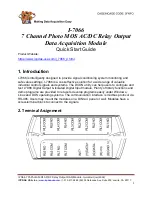
Overview
16
NX-Series Controllers - WebConsole & Programming Guide
These statistics indicate how many times mainline has been executed and why it has been executed. Repeatedly executing “show
interp stats” will give you an idea which code construct is causing mainline to execute. For example, if a variable is being changed,
you will see the “Variable Change” count increasing. If a timeline is firing quickly, you will see the TIMELINE_EXPIRATION count
increasing. A normal idle application that is executing DEFINE_PROGRAM every half second will only see the “Periodic Mainline”
count increasing.
For example, consider this diagnostic output from a NetLinx application that is changing a variable in DEFINE_PROGRAM:
>show interp stats
-- Mainline Executions due to:
Variable Change : 50927
Pending Int Event : 1
Pulse Expiration : 0
Hold Expiration : 0
DoPush Expiration : 0
Wait Expiration : 0
Until Expiration : 0
Timeline Expiration : 0
Periodic Mainline : 0
Current internal event count = 1
>show interp stats
-- Mainline Executions due to:
Variable Change : 62295
Pending Int Event : 1
Pulse Expiration : 0
Hold Expiration : 0
DoPush Expiration : 0
Wait Expiration : 0
Until Expiration : 0
Timeline Expiration : 0
Periodic Mainline : 0
Current internal event count = 0
>show interp stats
-- Mainline Executions due to:
Variable Change : 72386
Pending Int Event : 1
Pulse Expiration : 0
Hold Expiration : 0
DoPush Expiration : 0
Wait Expiration : 0
Until Expiration : 0
Timeline Expiration : 0
Periodic Mainline : 0
Current internal event count = 1
Notice the “Variable Change” count is increasing rapidly.
These diagnostics will not tell you where in your application the offending code resides. Finding the offending code requires a
process of code analysis and possibly selectively commenting out sections of code to isolate the offender.
NOTE:
NetLinx modules each have a DEFINE_PROGRAM section that must abide by the same rules as the main program, so the
offending code could be in a module.
















































